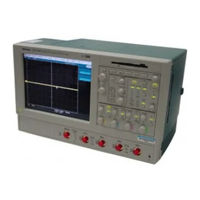
Tektronix TDS5052 Digital Oscilloscope Manuals
Manuals and User Guides for Tektronix TDS5052 Digital Oscilloscope. We have 3 Tektronix TDS5052 Digital Oscilloscope manuals available for free PDF download: User Manual, Service Manual
Tektronix TDS5052 User Manual (361 pages)
TDS5000 Series
Digital Phosphor Oscilloscopes
Brand: Tektronix
|
Category: Test Equipment
|
Size: 6 MB
Table of Contents
-
-
Preface18
-
Key Features22
-
Models22
-
Installation26
-
Unpacking26
-
Self Tests41
-
Options52
-
Accessories54
-
Left Side64
-
Rear64
-
Overview68
-
-
-
Interpolation101
-
Interleaving102
-
Using Fastframe109
-
Triggering116
-
-
Trigger Event117
-
Trigger Sources117
-
Trigger Types118
-
Trigger Modes118
-
Trigger Holdoff119
-
Trigger Coupling119
-
Slope and Level120
-
-
-
-
Purpose203
-
Using Math205
-
-
-
-
-
Window 3234
-
-
Gpib274
-
-
File Commands308
-
Edit Commands309
-
Trigger Commands312
-
Display Commands313
-
Cursors Commands314
-
Measure Commands314
-
Help Commands317
-
Glossary328
Advertisement
Tektronix TDS5052 User Manual (360 pages)
Digital Phosphor Oscilloscopes
Brand: Tektronix
|
Category: Test Equipment
|
Size: 5 MB
Table of Contents
-
Warranty3
-
Preface17
-
Models21
-
Key Features21
-
Installation25
-
Unpacking25
-
Self Tests40
-
Options51
-
Accessories53
-
Left Side63
-
Rear63
-
Overview67
-
Interpolation100
-
Interleaving101
-
Using Fastframe108
-
Triggering115
-
Horizontal Delay159
-
Display Elements166
-
Display Methods167
-
Zoom Controls171
-
Using Cursors191
-
Purpose202
-
Saving a Setup251
-
Gpib273
-
Display Features281
-
File Commands307
-
Edit Commands308
-
Trigger Commands311
-
Display Commands312
-
Cursors Commands313
-
Measure Commands313
-
Help Commands316
Tektronix TDS5052 Service Manual (256 pages)
Digital Phosphor Oscilloscopes
Brand: Tektronix
|
Category: Test Equipment
|
Size: 3 MB
Table of Contents
-
Installation43
-
General55
-
Front Panel56
-
Side Panels57
-
Power Supply57
-
Fans57
-
Printer57
-
Conventions60
-
First Step60
-
Self Tests63
-
Commands129
-
Test Results153
-
Maintenance169
-
Preventing ESD169
-
General Care170
-
Preparation175
-
Bottom Covers181
-
Right Side Cover182
-
Printer Frame183
-
Display Assembly190
-
Power Supply201
-
Troubleshooting209
-
Service Level209
-
Firmware Updates219
-
After Repair219
-
BIOS Beep Codes222
-
Packaging229
-
Module Servicing241
Advertisement


